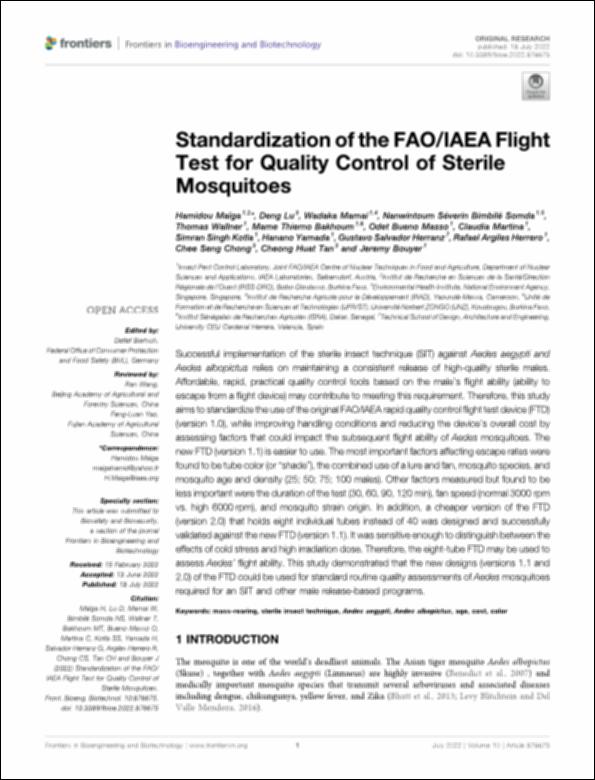Por favor, use este identificador para citar o enlazar este ítem:
http://hdl.handle.net/10637/14400Standardization of the FAO-IAEA flight test for quality control of sterile mosquitoes
| Título : | Standardization of the FAO-IAEA flight test for quality control of sterile mosquitoes |
| Autor : | Maïga, Hamidou Lu, Deng Mamai, Wadaka Somda, Nanwintoum Séverin Bimbilé Wallner, Thomas Bakhoum, Mame Thierno Salvador Herranz, Gustavo |
| Materias: | Culícidos - Cría y explotación.; Mosquitoes - Genetics - Control.; Mosquitoes - Breeding.; Culícidos - Genética - Control. |
| Editorial : | Frontiers Media |
| Citación : | Maïga, H., Lu, D., Mamai, W., Bimbilé Somda, N. S., Wallner, T., Bakhoum, M. T., Bueno Masso, O., Martina, C., Kotla, S. S., Yamada, H., Salvador Herranz, G., Argiles Herrero, R., Chong, C. S., Tan, C. H. & Bouyer, J. (2022). Standardization of the FAO/IAEA flight test for quality control of sterile mosquitoes. Frontiers in Bioengineering and Biotechnology, vol. 10, art. 876675 (18 jul.). DOI: https://doi.org/10.3389/fbioe.2022.876675 |
| Resumen : | Successful implementation of the sterile insect technique (SIT) against Aedes aegypti and Aedes albopictus relies on maintaining a consistent release of high-quality sterile males. Affordable, rapid, practical quality control tools based on the male’s flight ability (ability to escape from a flight device) may contribute to meeting this requirement. Therefore, this study aims to standardize the use of the original FAO/IAEA rapid quality control flight test device (FTD) (version 1.0), while improving handling conditions and reducing the device’s overall cost by assessing factors that could impact the subsequent flight ability of Aedes mosquitoes. The new FTD (version 1.1) is easier to use. The most important factors affecting escape rates were found to be tube color (or “shade”), the combined use of a lure and fan, mosquito species, and mosquito age and density (25; 50; 75; 100 males). Other factors measured but found to be less important were the duration of the test (30, 60, 90, 120min), fan speed (normal 3000 rpm vs. high 6000 rpm), and mosquito strain origin. In addition, a cheaper version of the FTD (version 2.0) that holds eight individual tubes instead of 40 was designed and successfully validated against the new FTD (version 1.1). It was sensitive enough to distinguish between the effects of cold stress and high irradiation dose. Therefore, the eight-tube FTD may be used to assess Aedes’ flight ability. This study demonstrated that the new designs (versions 1.1 and 2.0) of the FTD could be used for standard routine quality assessments of Aedes mosquitoes required for an SIT and other male release-based programs. |
| Descripción : | Este artículo se encuentra disponible en la siguiente URL: https://www.frontiersin.org/articles/10.3389/fbioe.2022.876675/full En este artículo de investigación también participan: Odet Bueno Masso, Claudia Martina, Simran Singh Kotla, Hanano Yamada, Rafael Argiles Herrero, Chee Seng Chong, Cheong Huat Tan y Jeremy Bouyer. Este artículo de investigación pertenece a la sección "Biosafety and Biosecurity". |
| URI : | http://hdl.handle.net/10637/14400 |
| Derechos: | http://creativecommons.org/licenses/by/4.0/deed.es |
| ISSN : | 2296-4185 (Electrónico) |
| Idioma: | es |
| Fecha de publicación : | 18-jul-2022 |
| Centro : | Universidad Cardenal Herrera-CEU |
| Aparece en las colecciones: | Dpto. Proyectos, Teoría y Técnica del Diseño y la Arquitectura |
Los ítems de DSpace están protegidos por copyright, con todos los derechos reservados, a menos que se indique lo contrario.


